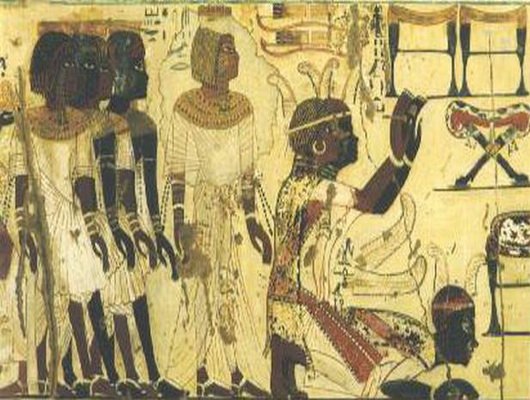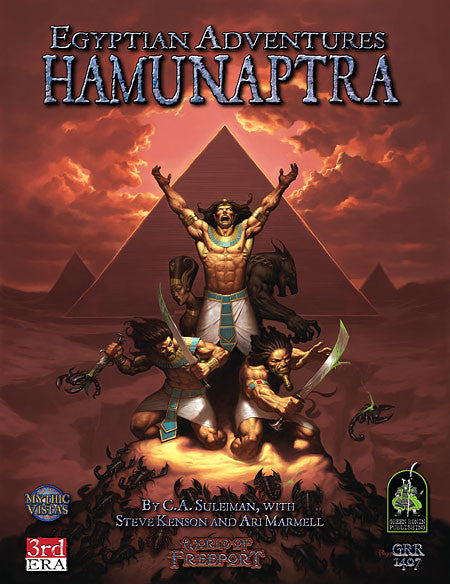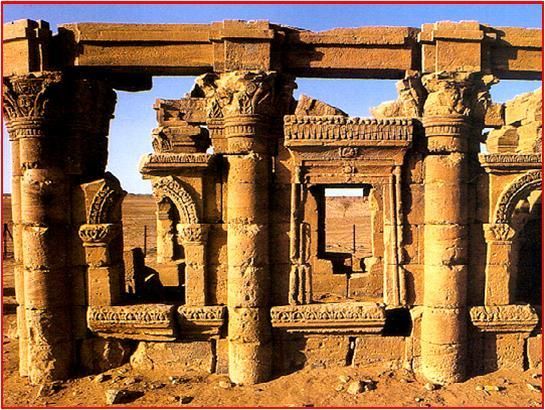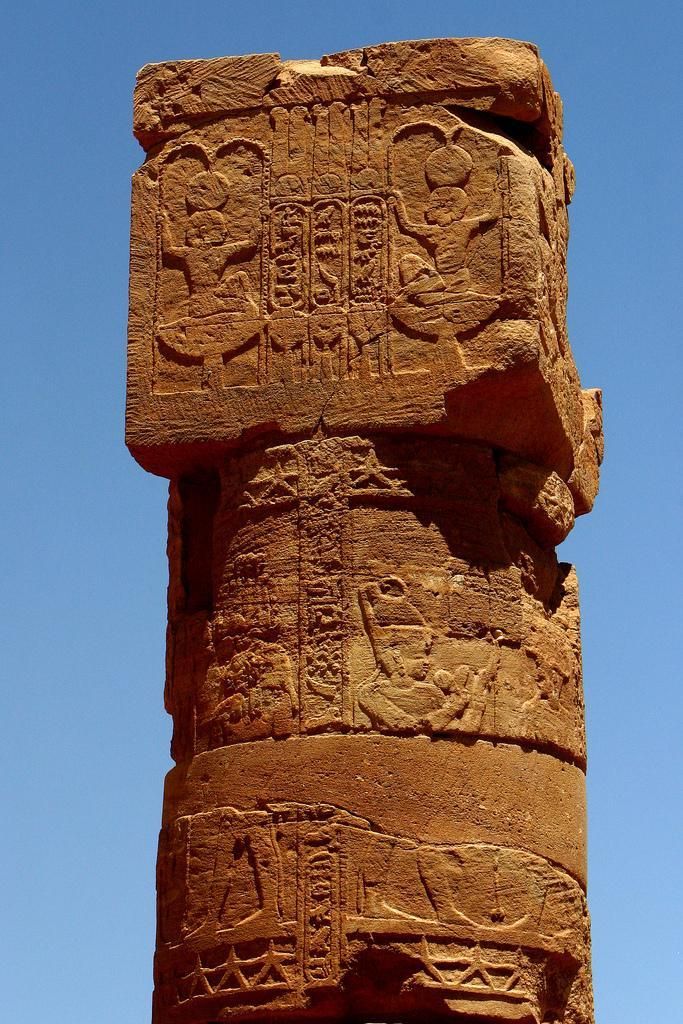Post by Admin on Oct 6, 2016 14:51:01 GMT
Keshu
Gummint: Kingdom
Pantheon: Egyptian

ΚΕΦΑΛΗΞΘ: Atazetmin II
CAPITAL: Hapobeid (Pop.: 50k)
Other Cities (and pop.):
Atramun: 25k
Gebordi: 10k <ISIS>
Kufra: 15k
Loc.: Afrik
Language: Aegyptian dialect
Pop.: 1,500,000+
Flag/Emblem:
Flag: Black scorpion on a
golden field.
Coinage: Aegyptian Standard.
Companions: Chiefs, clerics, offi.cia.ls, etc.
Friends: Meroe, Ziva.
Foes: Aegypt, Darfur, Lybbos.
Open Warfare/Skirmishing: With desert nomads && along Aegyptian && Darfurian borders.
Intrigues: Faction attempting acceptance of Meroen proposal to
invade the Nubian Oversight, while making peace with Lybbos.
Artifacts/Relics: The Keshi are said to have the potent Papyri of
Nine Steps and the Table ov Memory. It is supposed that some few
other objects ov minor sort are also possessed by this state.

Alignment: Neutral
Thumbnail Sketches: Much ov the land ov Keshu is rocky, barren,
&& desert. Its northern (Lybbos), eastern (Aegypt), && southern
(Meroe) borders are defined; but the King claims a vast tract stretching
W & S which is contested by nomadic desert tribesmen
(Tuareg, Bedoui, && Afula) && the lord ov Darfur. There are some
fertile strips along rivers && oases, ov course, && the N coast
region is quite fertile && well-watered, w/ grasslands reaching 50 to
80 miles inland behind the shore band. Thus, there are 3 distinct
climates && ecologies to be found in Keshu. Perhaps 5% ov the
land is very fertile, 15% suitable for pasturage, && the remaining
wilderness && desert. The fauna ov the latter regions incl.
some few elephants, rhinoceri, lions, leopards, giraffes, wild camels
&& asses, gazelles, hyenas, ostriches, && so on. There are few
towns && only 1 real city in the land: the oasis CAPITAL, Hapobeid,
which controls the junction ov several trade routes. Keshu is
desirous ov xtending its territories into the Sahara, ov course, because
ov the traffic to && from the S which brings gold, precious
stones, rare fragrances && oils, ivory, slaves, etc., && returns w/
weapons && metal goods, cloth, && so forth. The coastal port town
ov Atramun is a virtual backwater because the Keshi are unable to
compete w/ either the Phoenicians || Lybsossians, so most ov the
caravan TRADE passes through the ports in those lands rather than
Atramun<>.
The original inhabitants ov the region were prolly ov 2 sorts,
primitive Red race tribes && White race Berbers. The 2 eventually
intermixed so thoroughly as to form a distinct volk, the Keshi. In later
times there has been some addition of Yellow race (Bedoui) && Black
too (Meroean), but this is not significant, any more than absorption ov
Phoenician && Grecian colonists was. The society is still basically
one ov tribal sort, where all are generally =equal=, && the authority ov
the gummint is maintained principally through threat ov force, &&
by success. 1/3 ov the inhabitants are found in cities, towns, &&
settled villages. Ov the remainder, 1/2 are semi-nomadic && the
other part totally so. The latter are often questionably under control
ov the Crown.
The coastal regions are very productive, growing wheat, barley,
&& maize. Trees incl. the olive, fig, date, orange, lemon,
quince, citron, peach, almond, nectarine, apricot, pomegranate,
etc. Various veggies, melons, peanuts, && sesame<benne> are cultivated.
Cotton is also grown. Horses of good breeding, cattle,
sheep, && poultry are raised. Fishing provides for both food &&
export, including some amount of sponge.
Inland, the semi-nomadic
herders tend small fields of durra<>, lentils, beans &&
veggie crops. Some figs && dates are also tended. Livestock in this region
consists primarily ov horses, sheep, && goats, w/
some few cattle.
In the arid interior, oasis date palms, && some
few melons && veggies grown at such places, are all that is to
be had, save for the herds of camels, horses, && goats cared for
by the nomads.
There are mines in Keshu which yield very fine copper && a small
quantity ov iron. Some salt is gained from the coastal region, and also
some precious coral is found. Building stone is common. A considerable
number ov uncut sunorb gems are brought from the heart ov the
the Keshi desert, but their place ov origin is unknown, &&
experts agree that these stones are ov exotic sort, merely passing
through Keshu.
Gummint: Kingdom
Pantheon: Egyptian

ΚΕΦΑΛΗΞΘ: Atazetmin II
CAPITAL: Hapobeid (Pop.: 50k)
Other Cities (and pop.):
Atramun: 25k
Gebordi: 10k <ISIS>
Kufra: 15k
Loc.: Afrik
Language: Aegyptian dialect
Pop.: 1,500,000+
Flag/Emblem:
Flag: Black scorpion on a
golden field.
Coinage: Aegyptian Standard.
Companions: Chiefs, clerics, offi.cia.ls, etc.
Friends: Meroe, Ziva.
Foes: Aegypt, Darfur, Lybbos.
Open Warfare/Skirmishing: With desert nomads && along Aegyptian && Darfurian borders.
Intrigues: Faction attempting acceptance of Meroen proposal to
invade the Nubian Oversight, while making peace with Lybbos.
Artifacts/Relics: The Keshi are said to have the potent Papyri of
Nine Steps and the Table ov Memory. It is supposed that some few
other objects ov minor sort are also possessed by this state.

Alignment: Neutral
Thumbnail Sketches: Much ov the land ov Keshu is rocky, barren,
&& desert. Its northern (Lybbos), eastern (Aegypt), && southern
(Meroe) borders are defined; but the King claims a vast tract stretching
W & S which is contested by nomadic desert tribesmen
(Tuareg, Bedoui, && Afula) && the lord ov Darfur. There are some
fertile strips along rivers && oases, ov course, && the N coast
region is quite fertile && well-watered, w/ grasslands reaching 50 to
80 miles inland behind the shore band. Thus, there are 3 distinct
climates && ecologies to be found in Keshu. Perhaps 5% ov the
land is very fertile, 15% suitable for pasturage, && the remaining
wilderness && desert. The fauna ov the latter regions incl.
some few elephants, rhinoceri, lions, leopards, giraffes, wild camels
&& asses, gazelles, hyenas, ostriches, && so on. There are few
towns && only 1 real city in the land: the oasis CAPITAL, Hapobeid,
which controls the junction ov several trade routes. Keshu is
desirous ov xtending its territories into the Sahara, ov course, because
ov the traffic to && from the S which brings gold, precious
stones, rare fragrances && oils, ivory, slaves, etc., && returns w/
weapons && metal goods, cloth, && so forth. The coastal port town
ov Atramun is a virtual backwater because the Keshi are unable to
compete w/ either the Phoenicians || Lybsossians, so most ov the
caravan TRADE passes through the ports in those lands rather than
Atramun<>.
The original inhabitants ov the region were prolly ov 2 sorts,
primitive Red race tribes && White race Berbers. The 2 eventually
intermixed so thoroughly as to form a distinct volk, the Keshi. In later
times there has been some addition of Yellow race (Bedoui) && Black
too (Meroean), but this is not significant, any more than absorption ov
Phoenician && Grecian colonists was. The society is still basically
one ov tribal sort, where all are generally =equal=, && the authority ov
the gummint is maintained principally through threat ov force, &&
by success. 1/3 ov the inhabitants are found in cities, towns, &&
settled villages. Ov the remainder, 1/2 are semi-nomadic && the
other part totally so. The latter are often questionably under control
ov the Crown.
The coastal regions are very productive, growing wheat, barley,
&& maize. Trees incl. the olive, fig, date, orange, lemon,
quince, citron, peach, almond, nectarine, apricot, pomegranate,
etc. Various veggies, melons, peanuts, && sesame<benne> are cultivated.
Cotton is also grown. Horses of good breeding, cattle,
sheep, && poultry are raised. Fishing provides for both food &&
export, including some amount of sponge.
Inland, the semi-nomadic
herders tend small fields of durra<>, lentils, beans &&
veggie crops. Some figs && dates are also tended. Livestock in this region
consists primarily ov horses, sheep, && goats, w/
some few cattle.
In the arid interior, oasis date palms, && some
few melons && veggies grown at such places, are all that is to
be had, save for the herds of camels, horses, && goats cared for
by the nomads.
There are mines in Keshu which yield very fine copper && a small
quantity ov iron. Some salt is gained from the coastal region, and also
some precious coral is found. Building stone is common. A considerable
number ov uncut sunorb gems are brought from the heart ov the
the Keshi desert, but their place ov origin is unknown, &&
experts agree that these stones are ov exotic sort, merely passing
through Keshu.






